Don't wanna be here? Send us removal request.
Text
9/11
This is photo taken by Detective Greg Semendinger of the New York Police Department, of the collapsing of the twin towers on September 11th 2001. This photo was taken from the sky and it was just as the North tower was collapsing, engulfing lower Manhattan in smoke and ash. This attack came by the terrorist group al-Qaeda, and their leader was Osama Bin Laden at the time. The fires from Ground Zero continued to burn for 99 days after the attack. I discovered this image when looking through hundreds of photos taken during this horrific day and this one stood out to me significantly because I have never seen it before. It shows how destructive the collapse was from the sky and how much ground it covered across the city. The terrorist attacked killed thousands of people in just NYC alone and affected millions across America. This attack started our pursuit into Iraq and Afghanistan soon after the four coordinated terrorist attacks. I knew right when I was given the chance to pick a historical image of my choice that I would choose one form 9/11. This is the most significant and historic event that has occurred in the lifetime and that day will always be remembered in United Sates history. This image to me is a bit breath taking and is certainly an image I will not forget. America had not been attacked on their own soil since the British burned down the White House during the War of 1812. This image speaks for so much that occurred that day, the explosions, the smoke, the commotion of this tragic day will always be remembered and it is one of the most historic days in our nation’s existence.
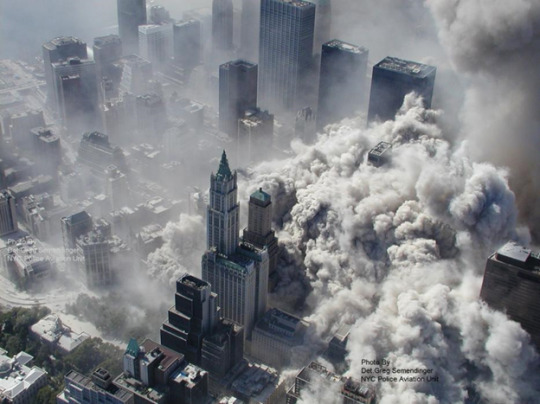
http://www.dailymail.co.uk/news/article-1249885/New-World-Trade-Center-9-11-aerial-images-ABC-News.html
0 notes
Text
Adams & Kobayashi
Ansel Adams was one of America’s most popular photographers because of his images from the Manzaner War Relocation Center in California of the Japanese Americans who were interned there during World War II. This image was taken of Tome Kobayashi while he stands in the south fields of the Manzanar Relocation Center, at the foot of the Sierra Nevada Mountains, in California’s Owens Valley in 1943 I found this image while scrolling through a bunch of Adams photos of the camps and this one just stuck me. Adams says, "The purpose of my work was to show how these people, suffering under a great injustice, and loss of property, businesses and professions, had overcome the sense of defeat and despair by building for themselves a vital community in an arid but magnificent environment." The photos that Adams took in California were allowed because of the friendship he had with the owner of the camp. The government did not want his photos being published with any sort of gun tower, barbed wire, or armed soldiers in the photos so Adams did his best to have some of those aspects in the far background of most of his images of the interned citizens. His photographs were taken in a mostly a positive light of the Japanese Americans, some with smiles on their faces, but that what his job was to do at first, because of the fearful country. Adam’s photos are very significant during this time period because of the way he chose to take his photos.
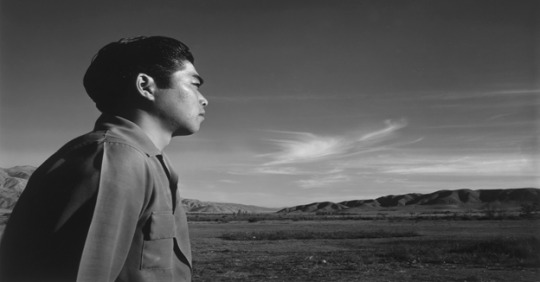
http://peopleus.blogspot.com/2010/10/japanese-internment-at-manzanar.html
0 notes
Text
“I Am a Man”
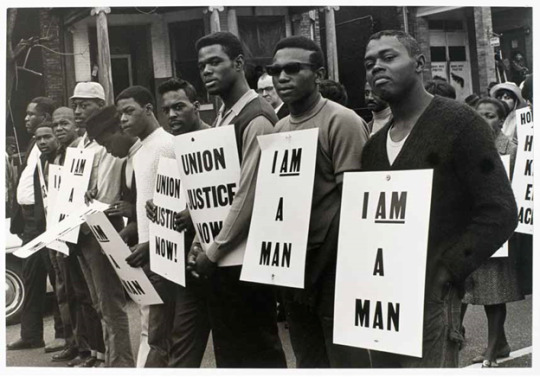
This photo taken by Builder Levy is title, “I Am a Man” taken in Memphis, Tennessee in 1968 during the Civil Rights Movement in the United States. The “I Am a Man” phrase is a declaration of civil rights, used as a personal statement against oppression. I found this image when searching the most influential images of the Civil Rights Movement and this was one of them that caught my eye because I had never seen this sign before. Hundreds of people flooded the streets with these signs and made their message very clear to the public during this time. This photo taken by Levy is one of the most significant during the Civil Right Movement because it was taken when the black sanitation workers went on strike in Memphis in the spring of 1968. Their signs read “I Am a man” in their fight for economic equality and this strike was the main reason why Martin Luther King Jr. was visiting Memphis when he was assassinated on April 4th, 1968. The 1300 black sanitation workers walked off their job to protest because of the poor treatment, dangerous working conditions, and the horrifying recent deaths of Echol Cole and Robert Walker. This image by Levy shows ten black men standing in a line holding their “I Am a Man” signs all but two looking at the camera almost in disgust. Their facial expressions show a lot to me, the chin up, stare face is somewhat powerful and intimidating, which is what they are trying to do I think. This picture was taken in a time where African-Americans were righting for equal rights and this was one of many strikes put together in America. Eventually things came together and we were able to agree to equality, but not before a lot of hatred and violence occurred in these years of Civil Rights Movements.
http://www.denverpost.com/lalife/ci_14114217?source=rss
0 notes
Text
3 Dead at Buna
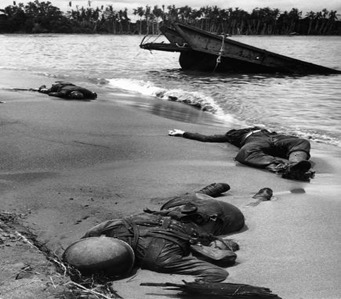
This photo was taken in 1943 during World War II at a place called Buna Beach. The photo was taken in February by George Strock and was not published in LIFE Magazine until September 20th, 1943. The caption from LIFE reads “Three dead Americans on the beach at Buna,” and I found this photo on time.com. Strock’s photo was the first time that any photographer depicted dead American troops in a public view. This photo has a great deal of symbolism and importance when trying to vision the brutally of war and the war at sea. This photo shows United States viewers something that they were not use to seeing, their own soldiers fighting for their country lying dead in the sand on the Pacific Ocean. This photo has been described as one of the most influential photographs ever taken and certainly one of the most influential during WWII. Strock’s photo shows three dead US soldiers lying in the sand, two of them face down and one of them sprawled out on his back laying lifelessly. A half sunken boat is seen in the background and the soldier closest to viewing is buried halfway in the sand with his helmet still on. This photo shows viewers that soldiers did not only die in the streets and battleground of hostile countries like Germany, but thousands of lives were lost at sea and this photo shows that. Many people may have thought this photo was not right to publish during this time period, but I think it would have brought people back to Earth a little bit seeing dead American soldiers for the first time, fighting to defend our nation.
http://time.com/3524493/the-photo-that-won-world-war-ii-dead-americans-at-buna-beach-1943/
0 notes
Photo

FSA (Walker Evans)
This photo was taken by Walker Evans, who was a member of the Farm Security Administration (FSA) during the Great Depression. This picture was taken in Alabama in 1935, of six member living in poor conditions in the southern part of the United Sates during tough times. Evans was hired to take photos and document them of the rural poor population in many southern states. Evans most popular work was this series of photos taken of the Alabama sharecroppers which was produced for Fortune Magazine. The FSA set up a publicity department to help explain to the people and government what its programs were trying to accomplish and problems they were trying to solve in society. Evans was to take photos of the achievements of the Neal Deal, which was out into place by President FDR to relief, recover, and reform America. The photo shows clearly that this family lives in a small wooden house, most likely 1 bedroom with 3 small children and an elderly women. Their cloths are all worn out and dirty, only the elderly women has shoes on and you can just tell that the family has limited resources to clean and wash themselves and their cloths. This was very common for families during the Great Depression and created difficult living conditions. I would say that the family does not particular look totally sad and out of it, they look like they just take it day by day and the parents work hard to support the family in any way possible. The mother looks pretty tired, most likely tending to the young kids all day and helping her husband out on the farm. This was a sharecropper family, in this case the father was a tenant farmer who gives part of each crop as rent to keep the house and support the family he has. In all this photo says a lot about the Great Depression and Evans does a great job in capturing a rural sharecropper family in their small home during one of the toughest times in American history.
http://www.livinghistoryfarm.org/farminginthe30s/water_14.html
0 notes
Text
Lewis Hine’s Impact
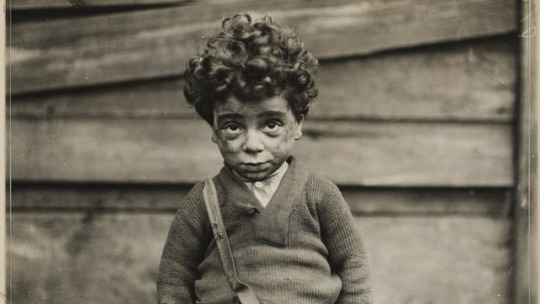
This is a photo taken by Lewis Hine in 1910 in an unknown location, most likely in either New York city of Chicago. The unofficial title of this photo reads, “Under Privileged Child at Hull House,” and this child is part of the horrific child labor that occurred in the early 1900’s after the arrival of the immigrant at Ellis Island. This phot stuck right out to me the moment I saw it because you can just see in the face what the boys is going though. He looks tired and sad, something that I am sure many children felt during this time. I discovered this photo on a BBC News link that described and shoed a short video of titled, “The child labor photos that shamed America.” The photographer Lewis Hine, used his camera as social reform and his images were very influential in changing the child labor laws in America. He took thousands of images of children working in harsh conditions all across America and Hine had a driving passion to get the point across that child labor needed to be reevaluated. Hine became an investigative photographer for the National Child Labor Committee and traveled all around to photograph children in their working conditions. It is known that Hine believed that if people could see for themselves the abuses that child labor caused, the evil laws would be changed. In 1916 the Keating-Owens Act established these more proper laws including a minimum of age 14 for workers in manufacturing and 16 for mining. Also, a maximum workday for these children was 8 hours. Hine states "There is work that profits children, and there is work that brings profit only to employers. The object of employing children is not to train them, but to get high profits from their work" (Lewis Hine, 1908). Child labor in the US was often referred to as “Child Slavery” and Hine was an instrumental character to help bring justice to these immigrant children who had to work in these awful conditions during the early 1900’s. These kids were being stripped of their education that they could have been receiving at a young age. Lewis Hine is a huge reason why child labor laws were put into place immediately and he should always be remembered as an influential person and photographer during this time in US history.
http://www.bbc.com/news/magazine-17673213
0 notes
Text
African American Family (Paris)
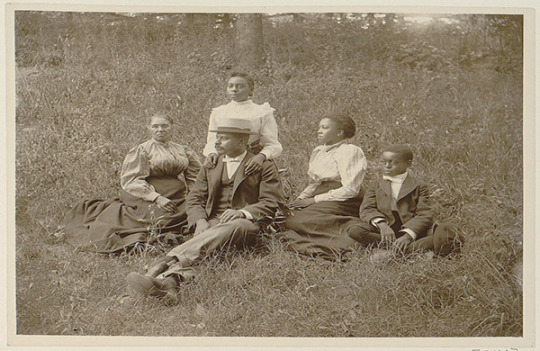
This photo was taken by William Edward Burghardt “W. E. B.” Du Bois in 1899 or 1900, part of 1900 Paris World’s Fair Exhibit. Du Bois collected hundreds photos of African Americans and published them at the Paris Exposition of 1900 where the US section exhibit featured the present conditions of African Americans. The Paris World Fair was a place to show social economy of countries and to celebrate the achievements of the past century including new inventions and architecture. This photo collected by Du Bois was an African American family posed for portrait while seated on a lawn. The where abouts of the photo is unknown as well as the family members name. The exhibits title was “The American Negro at Paris” and the photo shows five family members, presumably a mother, father, daughter, son, and grandmother. They are all staring into the distance to their right except for the grandmother who is looking directly into the camera. They look well clothed and they look fairly heathy as far as body weight is concerned. Nobody in the photo looks particularly happy but I would say that they do not look like they are in pain either. I found this image online on the Library of Congress link which has a lot of information about the World’s Fair as well as several other photos from the Du Bois collection. The image also does not have a title, it simply says “African American family posed for portrait seated on lawn.” Du Bois brought to one of the most recognizable events in the world a great collection of American photos that consisted of the African American people to give people of the World’s Fair an idea of what these people look like and what their roles were in the United States in 1900.
http://www.loc.gov/pictures/collection/anedub/dubois.html
0 notes
Photo

Lucille
Edward S. Curtis took this photo of a Dakota Sioux women standing in front of a tree in 1907. The title of the portrait the woman’s name, Lucille which shows her head and shoulders. She is dressed up in her native clothing including a headband and traditional long braided hair resting down from both of her shoulders. I found this image while scrolling through a website of all Curtis’s photos and it caught my eye because of the youth of the girl, almost my age and I was intrigued in discovering more about the image. Most of Curtis’s photos range from young children to elderly people, both men and women. The portraits are all of native people dressed in their traditional native clothing and appearance, including head gear, jewelry, face paint, and animal fur. Some of his portraits are taken with the person looking straight at the camera, other looking into the distance, Lucille is looking upward in this particular photo. Curtis also takes many photos of the native men in the outdoors on horseback or fishing, and the native women tending to their young. Curtis showed a great deal of courage exploring the native lands and their traditions, while taking photos and recording valuable visual evidence of Native American life in the US. Lucille I think is one of this finest pieces of work because of the clarity in the photo and the facial expression presented by the woman. She looks very comfortable and calm in front of the camera, looks very professional. Curtis created some incredible pieces of work we are still able to admire today and Lucille was just one of many.
http://commons.wikimedia.org/wiki/File:Lucille,_Dakota_Sioux,_by_Edward_S._Curtis,_1907.jpg
http://www.edwardcurtis.com/biography/
0 notes
Photo

The Civil War photograph that I chose to write about was taken by Timothy O’Sullivan of the Battle of Gettysburg titled “The Harvest of Death.” This was a photo taken by O’Sullivan that belongs in the Alexander Gardner Sketchbook of Civil War photography. This photo really exemplifies the horror of death during the Civil War and the title says it all about the photo taken, because the 1863 Battle of Gettysburg was one of the deadliest battles of the War between Union and Confederate soldiers. The photo was taken in Gettysburg, Pennsylvania in 1863 shows how Lee’s Confederate Army was defeated by the Union and General Meade’s Army walked away from the bloody battle victorious, ending Lee’s attempt to invade the North. This photo is so significant because many know that the Civil War was a gruesome battle and the way of handling the dead back then was difficult. O’Sullivan’s photo shows dozens of bodies lying lifelessly next to each other in the field of battle while men on horses in the background are identifying and possibly collecting bodies. Thousands of men were lost on both sides totaling over 7,000 dead and that is why this battle is so historically recognized as one of the most famous battles on American soil. O’Sullivan enhanced my knowledge about the Civil War just in this one photo because it shows how these men were left to die in a field next to one another, with no aid, no medical team, just their fellow Army mates to spend their last moments with. I think that this image is so powerful because of the way it is set up, with the man in front lying mouth open with another few soldiers lying around him and a whole bunch of soldiers sprinkled in the background lying dead. Timothy O’Sullivan’s “The Harvest of Death,” in Alexander Gardner’s Sketchbook of the Civil war serves as a historic photo which shows people what war and death was like back in 1861-1865.
0 notes
Photo

I chose the Mathew Brady portrait of General Robert E. Lee during the last year of the American Civil War. The photo is of three men, General Lee in the center, Major General George Washington Curtis Lee to his left, and Col. Walter Taylor to Lee’s right. The photo was taken by Brady on April 16th, 1865 in Richmond Virginia. Lee was a best known for commanding the Confederate Army of Northern Virginia during the war against the Union of the North. The picture takes place in front of a door of Lee’s home with General Lee staring right into the lenses while the other two men, who are standing at an angle, look straight ahead, not into the lenses. General Lee is positioned in a nice chair with his arms rested on the arm rests and his hat lying in his lap while he glares at Brady’s camera. The photo was taken just 7 days after the surrender and this photo was taken on Easter Sunday at Lee’s home in Richmond VA on 707 E. Franklin Street. It is known that Lee arrived in the city with five of his advisors. The significance of this photo is that it is soon after Robert E. Lee surrendered the last Confederate army to Ulysses S. Grant at Appomattox Courthouse on April 9th, 1865. The Confederate army had surrendered to the Union and marked a historic event in American history on that day. This photo was taken by Brady just a few days after this historic event and that is why this photo is valuable and important.
Sam Dexter
0 notes

